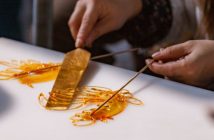"Art,” pronounced Joseph (age 6), "is boring."
Why? I asked.
“You just stand there and look at pictures. You don’t even get to do anything.”
“Craft is boring too,” he added hastily, to avoid any misconceptions. “But it’s not as bad as art.”
I was intrigued by his ideas, which were doubtless influenced by the Dadaist challenge to bourgeois conventions. A free and frank discussion followed, on the potential of art to inspire, to move, to make us see the world anew, before I came up with the decisive argument:
“Well, we’re going to look at some art, and you’re coming with us. And if you don’t like it, tough luck.”
And so we set off for the 798 Art district. This former factory complex, its grim buildings revealing their East German design, is now the setting for a hodgepodge of galleries, studios and cafes. We had two particular exhibitions in mind, but ended up wandering around and looking at anything that took our interest; in an afternoon, we only saw a fraction of what 798 has to offer.
I’ve always felt that contemporary art, with its playful irreverence, is more suitable for children than Old Masters. (I will never forget a three-year-old Noah’s deadpan verdict on the Louvre: “there’s lots of baby Jesuses.”) The street sculptures of 798 – flying pigs, giant children and bright red dinosaurs – elicited shrieks of laughter. Mysterious paintings of a smoggy Beijing also made a connection.
“I want to finish it,” Joseph said, contemplating an indistinct but recognizable street scene.
“But isn’t that how the city looks on foggy days?” I said. “Like a half-finished painting?”
Noah, now ten years old and more easy-going by nature, is one of life’s conciliators.
“When you said we were coming here, I was like, urngh, but actually it’s not too bad. It’s alright, isn’t it Joseph?”
798 is on the cusp of gentrification. There are plenty of shops selling overpriced wooden nicknacks, there are plans for hotels and “retail areas.” I did not have high hopes for a corporate gallery sponsored by Hyundai, with artworks inspired by (and mostly made from) their cars and trucks. However it turned out to be one of the highlights of our visit. The intimate relationships between people and vehicles provoked some funny and moving ideas, and the pieces were big, bold, and in one case, to my children’s delight, interactive.
At UCCA they got to make some art at last. For RMB 20 you can be Damien Hirst, and make a spin painting (although shark pickling was not on offer when we visited.) This drew a small crowd, and the boys found themselves becoming first artists, then exhibits, surrounded by clicking cameras. Nonetheless they were very proud of their work.

Over burger and chips, we reviewed our experience. So Joseph, do you still think art is boring?
“No.”
Then what would you say to the readers of beijingkids about 798?
“It’s good, and you should go there.”
So there you have it. 798: it’s good, and you should go there. And art? Officially not boring.
About the Author
Andrew Killeen is a novelist and creative writing teacher. He was born and brought up in Birmingham, England, studied English Literature at Cambridge University and now lives in Beijing with his wife and two sons, aged 10 and 6. In the UK he ran a weekly writers’ group, founded a literary festival and lectured in creative writing at Coventry University. He is also a qualified positive parenting practitioner. In his spare time he is a musician and DJ, and enjoys watching soccer and cricket, playing poker, and pontificating on social media. His critically acclaimed historical novels are available from Dedalus Books.
Photos: Courtesy of Andrew Killeen




